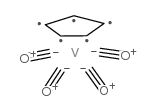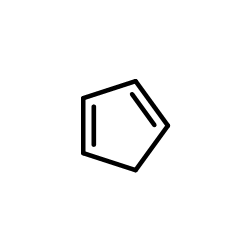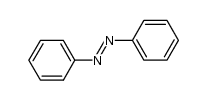12108-04-2
| 中文名 | 四羰基环五二烯基钒 |
|---|---|
| 英文名 | carbon monoxide,cyclopentane,vanadium |
| 英文别名 |
5,5-Diaethoxy-cyclopentadien
Cyclopentadienon-diethylketal 1,1-diethoxycyclopentadiene 5,5-Diethoxycyclopenta-1,3-dien 5,5-Diethoxy-1,3-cyclopentadien MFCD00014259 cyclopentadienylvanadium tetracarbonyl 1,3-Cyclopentadiene,5,5-diethoxy tetracarbonylcyclopentadienylvanadium cyclopentadienone-diethylketal EINECS 235-163-9 |
| 沸点 | 80-110ºC 0,1mm |
|---|---|
| 熔点 | 138ºC |
| 分子式 | C9H5O4V |
| 分子量 | 228.07500 |
| 精确质量 | 227.96300 |
| LogP | 0.18950 |
| 外观性状 | 固体 |
| 储存条件 | 常温密闭避光,通风干燥处 |
| 稳定性 | 常温常压下稳定 避免的物料 氧化物 |
| 分子结构 | 1、摩尔折射率:无可用的 2、摩尔体积(cm3/mol):无可用的 3、等张比容(90.2K):无可用的 4、表面张力(dyne/cm):无可用的 5、介电常数:无可用的 6、极化率(10-24cm3):无可用的 7、单一同位素质量:227.962748 Da 8、标称质量:228 Da 9、平均质量:228.0751 Da |
| 计算化学 | 1.疏水参数计算参考值(XlogP):无 2.氢键供体数量:0 3.氢键受体数量:4 4.可旋转化学键数量:0 5.互变异构体数量:无 6.拓扑分子极性表面积4 7.重原子数量:14 8.表面电荷:0 9.复杂度:21.6 10.同位素原子数量:0 11.确定原子立构中心数量:0 12.不确定原子立构中心数量:0 13.确定化学键立构中心数量:0 14.不确定化学键立构中心数量:0 15.共价键单元数量:6 |
| 更多 | 1. 性状:白色晶体 2. 密度(g/mL, 18 ℃ ):未确定 3. 相对蒸汽密度(g/mL,空气=1):未确定 4. 熔点(ºC):138 5. 沸点(ºC,常压):未确定 6. 沸点(ºC,0.1mmHg):80-100 7. 折射率:未确定 8. 闪点(ºC):未确定 9. 比旋光度(º):未确定 10. 自燃点或引燃温度(ºC):未确定 11. 蒸气压(20ºC):未确定 12. 饱和蒸气压(kPa,60ºC):未确定 13. 燃烧热(KJ/mol):未确定 14. 临界温度(ºC):未确定 15. 临界压力(KPa):未确定 16. 油水(辛醇/水)分配系数的对数值:未确定 17. 爆炸上限(%,V/V):未确定 18. 爆炸下限(%,V/V):未确定 19. 溶解性:未确定 |
|
Section 1: Product Identification Chemical Name:Cyclopentadienylvanadium tetracarbonyl, min. 97% CAS Registry Number:12108-04-2 Formula:C5H5V(CO)4 EINECS Number:235-163-9 Chemical Family:metallocene Synonym:none
Section 2: Composition and Information on Ingredients IngredientCAS NumberPercentACGIH (TWA)OSHA (PEL) Title compound12108-04-2100%0.05mg/m3 (as V)0.05mg/m3 (as V) Section 3: Hazards Identification Emergency Overview:Dust may be irritating to skin, eyes and respiratory tract. May be harmful if swallowed. Primary Routes of Exposure:Ingestion, inhalation Eye Contact:May cause slight or mild irritation of the eyes. Skin Contact:May cause slight to mild irritation of the skin. Inhalation:Dust may be irritating to the nose mucous membranes and respiratory tract. Ingestion:No specific information is available on the physiological effects of ingestion. May be irritating to skin, eyes and respiratory tract. Inhalation of large amounts may cause cough, bronchitis, Acute Health Affects: anemia, hematuria and nervous complaints. Chronic Health Affects:No information available on long-term chronic effects. NTP:No IARC:No OSHA:No SECTION 4: First Aid Measures Immediately flush the eyes with copious amounts of water for at least 10-15 minutes. A victim may need Eye Exposure: assistance in keeping their eye lids open. Get immediate medical attention. Wash the affected area with water. Remove contaminated clothes if necessary. Seek medical assistance if Skin Exposure: irritation persists. Remove the victim to fresh air. Closely monitor the victim for signs of respiratory problems, such as difficulty in Inhalation: breathing, coughing, wheezing or pain. In such cases seek immediate medical assistance. Seek medical attention immediately. Keep the victim calm. Give the victim water (only if conscious). Induce Ingestion: vomiting only if directed by medical personnel. SECTION 5: Fire Fighting Measures Flash Point:no data Autoignition Temperature:no data Explosion Limits:no data Extinguishing Medium:carbon dioxide, dry powder or foam. If involved in a fire, fire fighters should be equipped with NIOSH approved positive pressure self-contained Special Fire Fighting Procedures: breathing apparatus and full protective clothing. Hazardous Combustion andIf involved in a fire this material may release toxic organic fumes. Decomposion Products: Unusual Fire or Explosion Hazards: No unusual fire or explosion hazards. SECTION 6: Accidental Release Measures Small spills can be mixed with vermiculite, sodium carbonate or other suitable non combustible adsorbent and Spill and Leak Procedures: swept up. SECTION 7: Handling and Storage Handling and Storage:Handle and store the material under an inert atmosphere of nitrogen or argon. Store cold. SECTION 8: Exposure Controls and Personal Protection Eye Protection:Always wear approved safety glasses when handling a chemical substance in the laboratory. Skin Protection:Wear protective clothing and gloves. Ventilation:Material may form a fine dust. If possible, handle the material in an efficient fume hood. If ventilation is not available a respirator should be worn. The use of respirators requires a Respiratory Respirator: Protection Program to be in compliance with 29 CFR 1910.134. Ventilation:Material may form a fine dust. If possible, handle the material in an efficient fume hood. Additional Protection:No additional protection required. SECTION 9: Physical and Chemical Properties Color and Form:orange to red xtl. Molecular Weight:228.08 Melting Point:138° Boiling Point:(subl. 80-110°C /0.1mm Vapor Pressure:no data Specific Gravity:no data Odor:not determined Solubility in Water:insoluble SECTION 10: Stability and Reactivity Stability:air sensitive (store cold) Hazardous Polymerization:No hazardous polymerization. Conditions to Avoid:none Incompatibility:oxygen, oxidizing agents and halogens Decomposition Products:carbon monoxide, carbon dioxide, vanadium oxide and organic fumes. SECTION 11: Toxicological Information RTECS Data:No information available in the RTECS files. Carcinogenic Effects:no data Mutagenic Effects:no data Tetratogenic Effects:no data SECTION 12: Ecological Information Ecological Information:No information available SECTION 13: Disposal Considerations Disposal:Dispose of according to local, state and federal regulations. SECTION 14: Transportation Shipping Name (CFR):Non-hazardous Hazard Class (CFR):NA Additional Hazard Class (CFR):NA Packaging Group (CFR):NA UN ID Number (CFR):NA Shipping Name (IATA):Non-hazardous Hazard Class (IATA):NA Additional Hazard Class (IATA):NA Packaging Group (IATA):NA UN ID Number (IATA):NA SECTION 15: Regulatory Information TSCA:Not listed in the TSCA inventory SARA (Title 313):See Category code N770 for reporting. Second Ingredient:none SECTION 16 - ADDITIONAL INFORMATION N/A |
|
毒理学数据: 主要的刺激性影响: 在皮肤上面:刺激皮肤和粘膜 在眼睛上面:刺激的影响 致敏作用:没有已知的敏化现象 生态学数据: 通常对水体是稍微有害的,不要将未稀释或大量产品接触地下水,水道或污水系统,未经政府许可勿将材料排入周围环境。
|
| 危害码 (欧洲) | T+ |
|---|---|
| 风险声明 (欧洲) | 23/24/25 |
| 安全声明 (欧洲) | 26-28-36/37/39-45 |
| 危险品运输编码 | UN 3285 |
| 包装等级 | II |
| 危险类别 | 6.1 |
|
~75% 
12108-04-2 |
| 文献:Gambarotta, Sandro; Chiesi-Villa, Angiola; Guastini, Carlo Inorganic Chemistry, 1988 , vol. 27, p. 99 - 102 |
|
~79% 
12108-04-2 |
| 文献:Grobe, J.; Schneider, B. H.; Zimmermann, H. Zeitschrift fuer Anorganische und Allgemeine Chemie, 1981 , vol. 481, p. 107 - 116 |
|
~0% 
12108-04-2
详细
|
| 文献:Gambarotta, Sandro; Chiesi-Villa, Angiola; Guastini, Carlo Inorganic Chemistry, 1988 , vol. 27, p. 99 - 102 |
|
~% 
12108-04-2 |
| 文献:Gmelin Handbook: V: MVol.B1, 130, page 338 - 340 |
|
~% 
12108-04-2 |
| 文献:Gambarotta, Sandro; Chiesi-Villa, Angiola; Guastini, Carlo Inorganic Chemistry, 1988 , vol. 27, p. 99 - 102 |
|
~% 
12108-04-2 |
| 文献:Gambarotta, Sandro; Chiesi-Villa, Angiola; Guastini, Carlo Inorganic Chemistry, 1988 , vol. 27, p. 99 - 102 |
| 上游产品 8 | |
|---|---|
| 下游产品 0 | |










